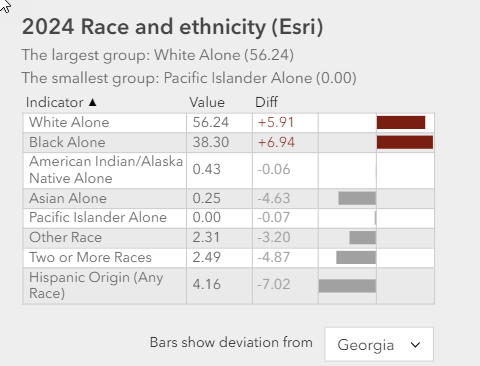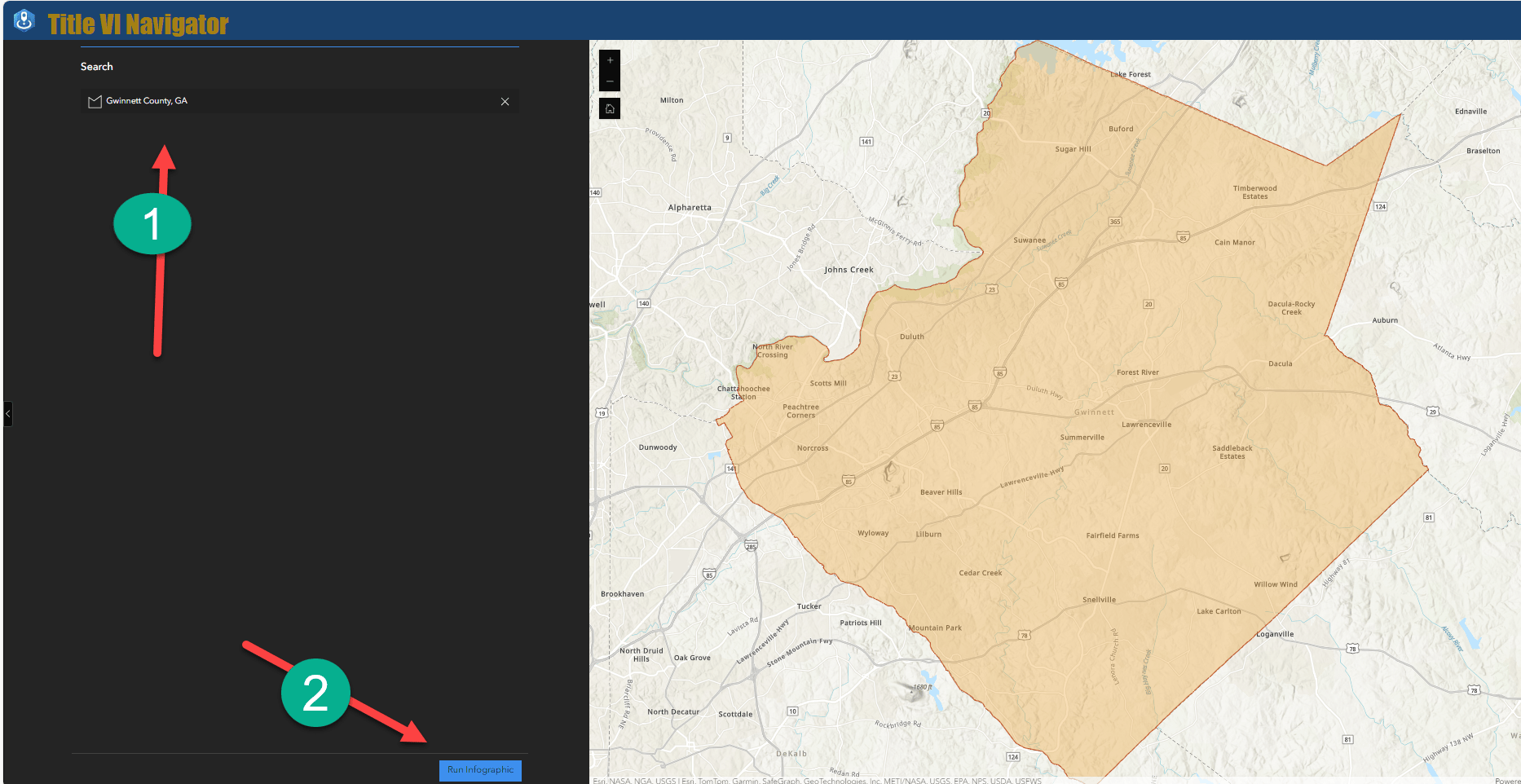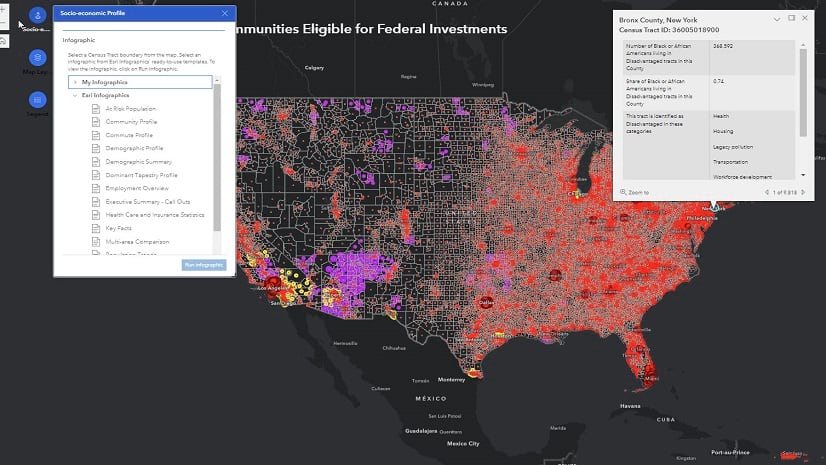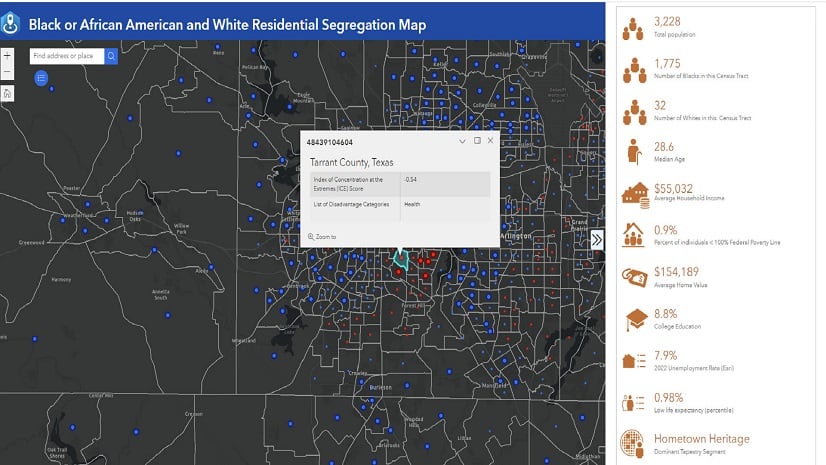Title VI of the Civil Rights Act of 1964 mandates that no individual in the United States shall, on the grounds of race, color, or national origin, be excluded from participation in, be denied the benefits of, or be subjected to discrimination under any program or activity receiving federal financial assistance. Ensuring compliance with this regulation is crucial for a wide range of organizations including government agencies, schools, colleges, and universities, hospitals and healthcare facilities, social service agencies, and any other entities or programs that receive federal funding.
Say hello to Title VI Navigator, a tool designed using ArcGIS Experience Builder and the Business Analyst widget to facilitate this essential compliance. The Title VI Navigator app simplifies the process of assessing compliance and ensures that organizations can proactively address areas of concern, promoting fairness and equality in service provision across diverse communities.
The core of Title VI Navigator is its infographic template, which leverages data from the most recent American Community Survey (2018-2022) and Esri’s 2024 demographic data to provide a comprehensive visual overview. This template is instrumental for organizations in analyzing crucial aspects of their communities—demographics, economic status, language diversity, and accessibility. It highlights the key metrics vital for Title VI compliance, such as racial and ethnic composition of an area, low-income populations, limited English proficiency, and access to services, enabling organizations to ensure they meet federal guidelines.
Key metrics for Title VI compliance
- Low-income populations
The Title VI Navigator infographic shows the percentage of the population in a chosen location living below 150% of the poverty threshold. This metric is crucial for Title VI compliance, as federal guidelines often use the 150% marker to identify economically disadvantaged groups who might be underserved. Special attention to service delivery in these low-income areas helps prevent exclusion based on economic status, ensuring that federal funds support those most in need in a fair and equitable manner. This approach aligns with the broader goals of Title VI to promote inclusion and equal access to services.

This bar chart in the Title VI Navigator infographic uses different colors to distinguish between income groups: red bars represent populations living below the poverty line (less than 1.50 times the poverty threshold), while blue bars represent populations living above the poverty line (1.50 times the poverty threshold and above). The chart shows that nearly 40% of the population in Wheeler County, GA, lives below the 150% poverty threshold. This rate is almost three times higher than the official poverty rate in the United States, which is approximately 11.5%. This significant disparity indicates a higher level of economic hardship in Wheeler County, underscoring the need for targeted support and resources to ensure compliance with Title VI requirements and promote equitable access to services.
- Minority populations
The Title VI Navigator infographic details the composition of various racial and ethnic groups within the community. Identifying minority populations is particularly important for Title VI compliance, as it ensures that all racial and ethnic groups, especially those in minority categories, have equitable access to federally funded services. This data is essential for monitoring and addressing potential disparities, helping organizations proactively ensure that services are distributed fairly and without discrimination, in line with Title VI’s goal of fostering an inclusive environment.

This infographic panel shows that the largest group in Wheeler County, GA, are those who identify as White alone, at 56%. The largest minority group is those who identify as Black alone at 38%, which is nearly 7% higher compared to the state of Georgia. This difference suggests that Wheeler County has a higher concentration of Black residents than the state average, which may indicate a need for targeted outreach and resources to ensure equitable access and compliance with Title VI requirements.
- Limited English-proficient populations
The Title VI Navigator infographic lists the languages spoken and assesses English proficiency levels. The Language Spoken at Home panel identifies community members with limited English skills, highlighting the need for language assistance services to ensure compliance with Title VI. This panel provides insights into the linguistic diversity of the area, underlining the importance of translation and interpretation services to prevent language barriers from denying access to services. This ensures programs are accessible to all, regardless of language ability.

This table in the Title VI Navigator infographic shows that in Los Angeles County, the share of those who speak only English is at 44%, which is lower than many other counties in the U.S. More than 38% speak Spanish, and over 10% speak Asian and Pacific Island languages. Of those who speak Spanish, one in four are limited English proficient. This highlights the importance of providing multilingual resources and services to ensure compliance with Title VI and to support equitable access for residents with limited English proficiency.
- Other Vulnerable populations
The Title VI Navigator infographic identifies segments like the elderly, disabled, or those without vehicle access. Title VI emphasizes the need to accommodate the most vulnerable to ensure equitable access to all programs, making this data critical for compliance evaluations.
Using Title VI Navigator
Title VI Navigator is built using ArcGIS Experience Builder, making it easy for users to navigate and interact with the data. The search function is limited to counties, aligning with the operational scope of many organizations that receive federal funding, ensuring relevant and manageable data for compliance assessments.
Real-World Application: To see the tool in action, search for “Gwinnett County, GA” in the Title VI Navigator search bar and run the infographic.

The data, shown below, reveals that nearly 20% of residents live below 150% of the poverty threshold. Additionally, almost 1 in 4 Spanish speakers and over 28% of Asian speakers have limited English proficiency, highlighting the need for targeted language assistance services. The minority chart indicates that Gwinnett County hosts 12% more people of Hispanic origin compared to the state of Georgia, underscoring the importance of inclusive service planning.

Conclusion
Title VI Navigator is an essential tool for organizations receiving federal funding, helping them meet key federal requirements under Title VI effectively. By providing a clear and comprehensive analysis of demographic, economic, and linguistic data, the app ensures that organizations can promote inclusion and equal access to services, aligning with the overarching goals of Title VI.
By using Title VI Navigator, organizations can develop informed public participation plans, coordinate with community organizations, and implement effective public engagement strategies. This ensures compliance with Title VI, fostering a more inclusive and equitable service provision for all community members.




Article Discussion: